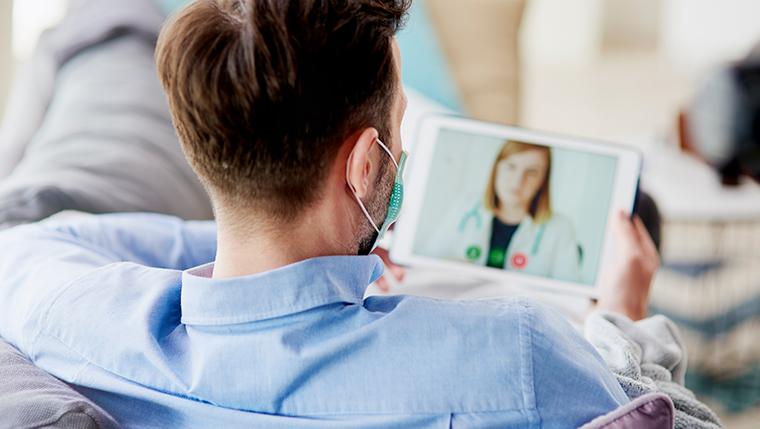As millions of Americans stay home to help flatten the curve and keep themselves and their loved ones healthy amid the coronavirus pandemic, our usual way of life has changed.
No longer are we heading to the local coffee shop for a cup of joe and a chat with friends; our kids aren't going on playdates, and we aren't exploring our city's restaurant scene.
But it's not just our daily routines that have been altered, in some cases, it's our health, whether that means putting off our annual exams or that dental work we had scheduled for next month.
Amid the pandemic, even in the case of an emergency, Americans might be reluctant to visit a hospital or urgent care clinic in fear of being exposed to COVID-19.
For these reasons, telemedicine has seen an uptick in use in recent weeks.
The technology, which has been around for quite some time, not only eliminates one avenue of exposure for Americans worried about the virus, it also alleviates the strain on America's healthcare system.
What is Telemedicine?
Telemedicine is the use of electronic and telecommunication technologies and services to provide healthcare and support at a distance.
In most cases, the U.S. Department of Health and Human Services recognizes that telemedicine involves the use of live videoconferencing, remote patient monitoring, and the transmission of resources virtually.
Telemedicine was created as a way to help improve patient outcomes and access to care while resulting in cost savings for the healthcare system.
Convenience of Telemedicine
While there are a number of reasons one might consider seeking telemedicine medical assistance, right now, the conveniences of such services hinge on keeping consumers safe and healthy.
Traditional conveniences of telemedicine include not having to leave your home for care, reduction in wait times, and, at times, cost savings.
Though these benefits still apply during the COVID-19 pandemic, the ability to reduce exposure to patients and medical professionals, as well as free-up hospital resources, are the top conveniences of the system.
Telemedicine During COVID-19
Though consumers have been using aspects of telemedicine for years, the current situation with COVID-19 has made the system more appealing to many Americans.
Whether or not someone is showing symptoms of COVID-19, the Centers for Disease Control and Prevention have strongly discouraged people from merely driving to the hospital or doctor's office unless it is a true emergency.
According to the CDC, medical practices should explore alternatives to face-to-face triage and visits with patients to reduce unnecessary contact and prevent exposure or transmission of COVID-19.
By moving to telemedicine, Americans can also keep the capacity at hospitals down, freeing resources and doctors to care for patients with COVID-19.
The system has, thus far, proven to be an effective and sustainable solution for precaution, prevention, and treatment amid the pandemic.
As mentioned above, there are two ways in which telemedicine can be used during this time: to care for and monitor COVID-19 positive or presumptive positive patients, and to care for those who do not have COVID-19 symptoms but require medical attention.
Telemedicine For COVID-19 Patients
Those who are experiencing flu-like symptoms - such as fever or cough - are asked to call their doctor to determine if they should see a doctor in-person, according to the CDC.
This is important during the COVID-19 pandemic because those infected, even if they aren't showing symptoms, can quickly spread the disease to others.
By using telemedicine, potential patients ensure they aren't spreading the virus to other patients or medical professionals.
If it's believed that the potential patient is at-risk of having COVID-19, they'll be instructed to acquire a test and self-quarantine at home.
During this time, the patient can keep in touch and seek treatment options via telemedicine with their doctors. If symptoms worsen and a patient must seek in-person medical attention, the CDC urges them to call before leaving their home so their doctors can prepare for their arrival.
Non-COVID-19 Patients
The CDC, as well as many medical professionals around the country, have also urged those who have not been exposed to COVID-19 to continue to avoid exposure by not visiting emergency rooms or clinics unless absolutely necessary.
This is especially important for people who have chronic illnesses and are more at risk of complications should they become infected.
In many cases, physicians are rescheduling routine doctor's appointments and elective surgeries for a later date to avoid exposing patients unnecessarily.
However, if a patient has standing appointments to address chronic illnesses such as diabetes, the CDC encourages medical professionals to move these meetings to a telemedicine method.
Telemedicine Costs
As Americans continue to navigate their lives during the COVID-19 pandemic, their health remains a top priority.
While the main benefit of telemedicine during the COVID-19 pandemic is the reduction of exposure to the virus for Americans and medical professionals, it could also be an effective way to cut your medical costs.
Recent studies have found that the use of telemedicine can reduce costs for patients. Mainly, these costs can be realized by diverting patients away from costly care settings.
For instance, a visit to the doctor or a hospital stay can come with a significant price tag. By staying home and receiving care via telephone call or video conference, patients are eliminating that cost.
There are a number of telemedicine options available to consumers, including Teladoc, a service covered by First Family Insurance.
For more information on Teladoc services, visit our website.



 Everything You Need to Know About Teladoc
Everything You Need to Know About Teladoc
 How Important is Dental Insurance?
How Important is Dental Insurance?
 Pre-existing Conditions and Short-Term Medical
Pre-existing Conditions and Short-Term Medical
 5 Easy Exercises You Can Do at Home!
5 Easy Exercises You Can Do at Home!
